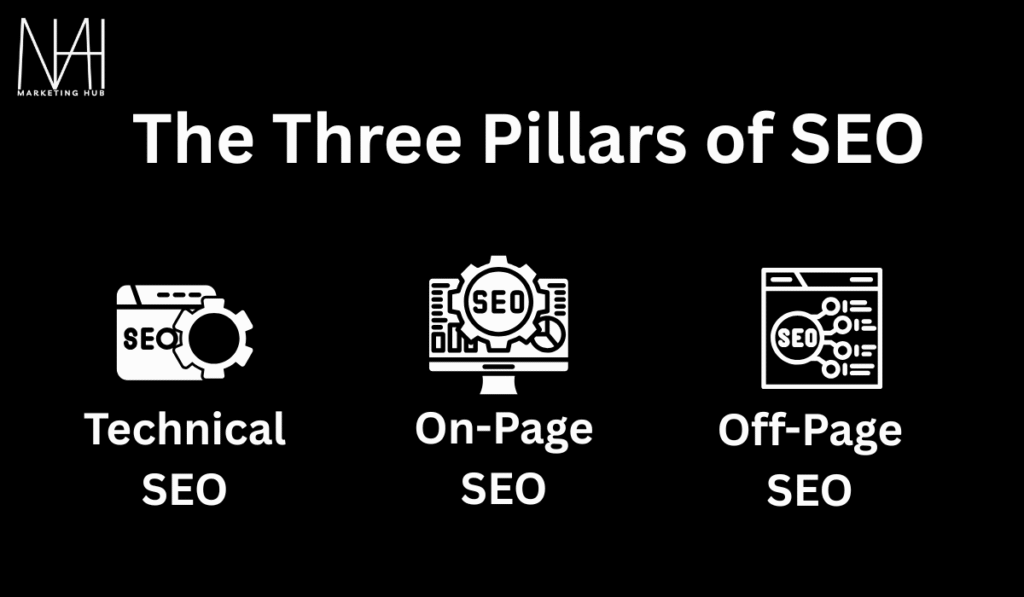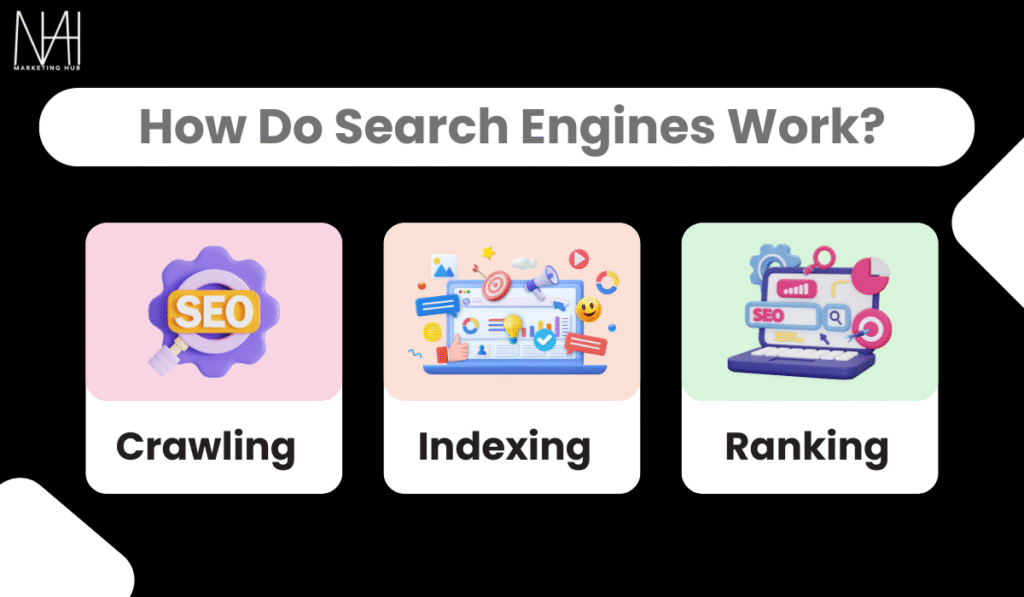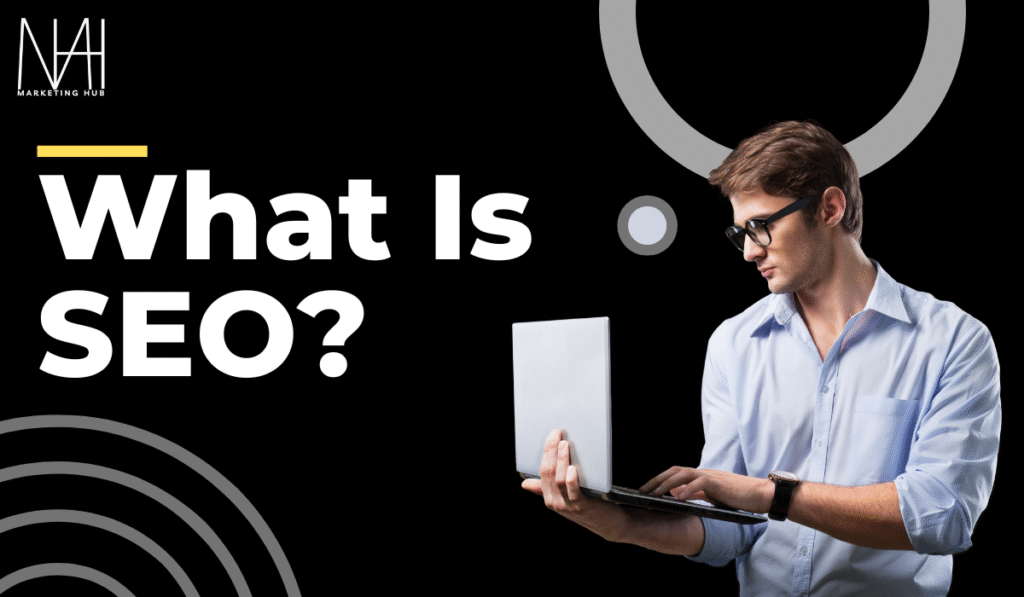Are you starting your journey into Search Engine Optimization (SEO)? Whether you’re a business owner, marketer, or content creator, understanding SEO can help increase your website traffic, visibility, and leads.
At Marketingg Hubb, we believe SEO doesn’t have to be complicated. In this guide, we’ll explain SEO in simple terms, explore how it works, and introduce the role of AI in search marketing. If you understand how search engines evaluate content and rank web pages, you’ll be better equipped to craft a strategy that gets results.
What Is SEO?
SEO (Search Engine Optimization) is the process of improving your website’s visibility in search engine results. The goal is to drive organic (non-paid) traffic from search engines like Google, Bing, and Yahoo by optimizing your content, site structure, and authority.
Think of SEO as a way to signal to search engines that your website is relevant, useful, and worth showing to users. When someone searches for a term related to your business, your goal is to appear at the top of those search results. Appearing higher in SERPs (Search Engine Results Pages) can result in increased visibility, web traffic, and customer conversions.
The Three Pillars of SEO
SEO success depends on three main components. These foundational pillars ensure your website is technically sound, filled with relevant and valuable content, and trusted by other authoritative websites.

1. Technical SEO
Technical SEO involves all the backend work needed to help search engines crawl and index your website more efficiently. It includes tasks like:
- Increasing your site’s loading speed and ensuring fast page performance
- Creating a mobile-friendly and responsive design that works on all devices
- Securing your website with HTTPS and SSL certificates
- Structuring your website logically through clean navigation and internal linking
- Implementing structured data (Schema markup) for better rich snippets
- Submitting your XML sitemap to search engines and optimizing your robots.txt file
If your technical SEO is lacking, search engines might not be able to discover or understand your content properly. Without proper indexing, even the best content may never be seen.
2. On-Page SEO
On-page SEO focuses on optimizing individual pages on your site so they rank higher and earn more relevant traffic. This includes:
- Conducting keyword research to target terms your audience is searching for
- Creating high-quality, original, and informative content tailored to user needs
- Crafting optimized title tags, meta descriptions, and header tags (H1, H2, etc.)
- Using descriptive image alt tags and compressing images for faster loading
- Enhancing user experience through clean formatting, internal links, and readability
By implementing on-page SEO best practices, your content becomes easier for both users and search engines to understand and value.
3. Off-Page SEO
Off-page SEO focuses on actions taken outside your own website to impact your rankings. The most crucial part is link building, but it also includes:
- Acquiring backlinks from authoritative and relevant websites
- Promoting your content on social media platforms
- Engaging with online communities and forums to establish credibility
- Collaborating with influencers and guest blogging on industry sites
- Encouraging online reviews and mentions of your brand
Off-page SEO is essentially about building your website’s authority and reputation across the internet. The more credible and trusted your site appears, the better it will rank.
Paid vs Organic Search
Understanding the difference between paid and organic search helps you align your digital marketing budget and goals effectively.
Paid Search
With paid search (also known as pay-per-click or PPC), businesses pay to appear at the top of search engine results pages. It provides instant visibility and can be extremely effective for short-term goals, promotions, or competitive industries.
Organic Search
Organic search traffic is earned by optimizing your website for SEO. This method doesn’t require direct payment for clicks but does involve ongoing effort in content creation, optimization, and technical improvements. It’s slower to build but highly sustainable and cost-effective in the long run.
Key Differences:
- Positioning: Paid search ads appear above the organic listings.
- Cost: Paid search involves a cost-per-click (CPC) model, while organic search is free but resource-intensive.
- Time: Paid search results are immediate; organic rankings can take months.
- ROI: Organic traffic tends to deliver higher ROI over time with lower ongoing costs.
Similarities:
- Both require keyword research and targeting
- Both benefit from optimized landing pages
- Both aim to meet user search intent and drive conversions
How Do Search Engines Work?
Search engines like Google use automated bots to explore the web and return the best possible results to searchers. This process has three key stages:

Step 1: Crawling
Search engines use web crawlers (or spiders) to scan the internet and discover new or updated pages. These bots follow links from page to page and website to website, collecting data.
Step 2: Indexing
Once content is discovered, it’s stored and organized in a massive database called an index. If your content is original, valuable, and meets technical guidelines, it gets indexed and becomes eligible to rank in results.
Step 3: Ranking
Ranking is the process of determining which content is most relevant to a search query. Google uses hundreds of signals like keyword relevance, page speed, backlinks, and user engagement to determine rankings.
How Google Ranks Content
Google’s ranking system relies heavily on AI, especially algorithms like RankBrain, BERT, and MUM. RankBrain helps Google understand unfamiliar queries by interpreting search intent and connecting terms.
Additionally, Google considers E-E-A-T: Experience, Expertise, Authoritativeness, and Trustworthiness. This framework helps determine which websites provide reliable, helpful content.
How to Optimize for RankBrain:
- Use natural, conversational language in your content
- Align your content with user intent, not just keywords
- Optimize your page titles and meta descriptions for high click-through rates
- Create engaging content that encourages users to stay longer on the page
- Include visuals, videos, and interactive elements to improve engagement
Building an SEO Strategy
An SEO strategy is your plan of action to improve search visibility, boost traffic, and achieve specific goals. A focused strategy helps you stay organized and on track.
Steps to Build Your SEO Strategy:
- Define Your Goals: Set objectives based on traffic, conversions, or brand awareness
- Conduct Keyword Research: Discover what your audience is searching for
- Plan Your Content: Build a content calendar around keywords and audience needs
- Optimize Content and Pages: Ensure every page is optimized for search and usability
- Build Authority: Gain backlinks through partnerships, PR, and valuable content
- Monitor Results: Use tools like Google Analytics and Search Console to track success
Setting SEO Objectives
Setting clear, realistic goals is key to a successful SEO strategy. Your goals should align with your overall business targets and be measurable over time.
Sample SEO Objectives:
- Improve keyword rankings for top 30 search terms
- Increase organic website traffic by 30% within six months
- Boost conversion rates from blog content by 15%
- Reduce bounce rate on landing pages by 20%
Metrics to Measure:
- Keyword rankings and impressions
- Organic traffic volume and sessions
- Time on page and average session duration
- Bounce rate and engagement levels
- Domain authority and backlink count
- Lead generation and ROI from organic traffic
Whether you’re a product-based e-commerce business or a service provider, tailor your SEO objectives to reflect your target audience and business structure.
Career Spotlight: Becoming an SEO Specialist
Interested in SEO as a career path? As more businesses shift online, the demand for SEO professionals is growing rapidly.
Skills You Need:
- Master keyword research and competitive analysis
- Understand link-building techniques and outreach strategies
- Gain knowledge in technical SEO (sitemaps, robots.txt, schema markup)
- Analyze traffic and rankings using analytics tools
- Develop strong writing and editing skills for optimized content
Soft Skills:
- Critical thinking and problem-solving
- Project management and communication
- Staying up to date with industry trends
Salary Range in the U.S. (Approximate):
- Entry Level: $49k – $72k/year
- Mid-Level: $62k – $110k/year
- Senior-Level/Manager: $80k – $150k/year
- Director or Head of SEO: $110k – $192k/year
AI and the Future of SEO
Artificial intelligence is rapidly transforming SEO. From keyword research and content creation to predictive analytics and automation, AI is shaping how we optimize and strategize.

AI Trends in SEO:
- Google SGE (Search Generative Experience): AI-powered search answers and summaries
- Answer Engine Optimization: Preparing content for tools like ChatGPT, Gemini, and Alexa
- Video SEO: Optimizing videos for YouTube, TikTok, and social platforms
- Core Web Vitals: Focusing on page speed, interactivity, and stability
- Predictive SEO Tools: Tools like RankSense, Surfer SEO, and Clearscope
Top Tools for SEO Success
Free Tools:
- Google Search Console: Tracks indexing and technical issues
- GA4 (Google Analytics): Monitors traffic, conversions, and user behavior
- Google Keyword Planner: Keyword research tool
- PageSpeed Insights: Analyzes and improves site speed
Paid Tools:
- SEMrush: All-in-one SEO and content marketing platform
- Ahrefs: Backlink analysis and competitor research
- Screaming Frog: Site audit and crawl diagnostics
- Moz Pro: Keyword tracking and optimization tools
- Surfer SEO: Content creation and optimization based on SERPs
These tools make it easier to identify opportunities, fix issues, and stay competitive.
Final Thoughts: Why SEO Still Matters in 2025
SEO remains one of the most cost-effective and impactful digital marketing strategies. While algorithms evolve and platforms change, the goal of delivering valuable content to users stays the same.
By investing in SEO, you create long-term value, drive consistent traffic, and strengthen your brand’s presence in the digital world. With the rise of AI, voice search, and smarter algorithms, adapting and staying current is essential.
At Marketingg Hubb, we’re here to guide you on your SEO journey—from basics to advanced tactics. Whether you’re just starting out or refining your strategy, we’re your trusted digital partner.
FAQs about SEO
1. How long does it take to see results from SEO?
SEO is a long-term strategy, and most websites start seeing noticeable improvements in rankings and traffic within 3 to 6 months. However, this can vary based on competition, industry, keyword difficulty, and how consistent your optimization efforts are.
2. What are the main types of SEO?
There are three main types of SEO: On-page SEO focuses on optimizing your content, meta tags, and internal links; Off-page SEO involves building backlinks and boosting domain authority through external sources; and Technical SEO includes optimizing your website structure, mobile-friendliness, loading speed, and indexing.
3. Is SEO better than paid advertising?
SEO and paid advertising serve different purposes. SEO offers long-term organic growth and is cost-effective over time, while paid advertising brings immediate visibility and quick traffic. A combination of both often provides the best results, especially for growing businesses.
4. How do keywords affect SEO?
Keywords are essential in SEO because they help search engines understand the topic and relevance of your content. When you use the right keywords strategically in titles, headings, and throughout your content, it increases the chances of your website ranking for those search terms.
5. What are backlinks, and why are they important?
Backlinks are incoming links from other websites to your site. They act like endorsements, signal to search engines that your content is trustworthy and authoritative. High-quality backlinks can significantly improve your search rankings and online credibility.
6. Can I do SEO on my own, or do I need an expert?
Basic SEO can definitely be done by yourself using online tools, plugins, and tutorials. However, if you are in a competitive industry or running a large website, hiring an SEO expert or agency can help you implement advanced strategies and achieve better results faster.
7. Does SEO work for all types of businesses?
Yes, SEO can benefit all types of businesses—whether you’re running a local service, an e-commerce store, or a global brand. The key is to customize your SEO strategy based on your audience, business goals, and industry trends.
8. How often should I update my website for SEO?
To keep your website SEO-friendly, it’s important to update your site regularly with fresh content, accurate information, and technical improvements. Blog posts, updated product pages, or new service pages can help keep your site active in the eyes of search engines.
9. What are the most important Google ranking factors?
Some of the most important Google ranking factors include high-quality content, page speed, mobile responsiveness, secure website (HTTPS), user experience, backlinks, keyword usage, and site structure. Google’s algorithm also values content that satisfies search intent.
10. Is SEO a one-time effort?
No, SEO is an ongoing process. Search engine algorithms evolve, competitors update their strategies, and user behavior changes. To maintain and improve your rankings, you need to continuously monitor performance, update content, and adapt your SEO practices.

